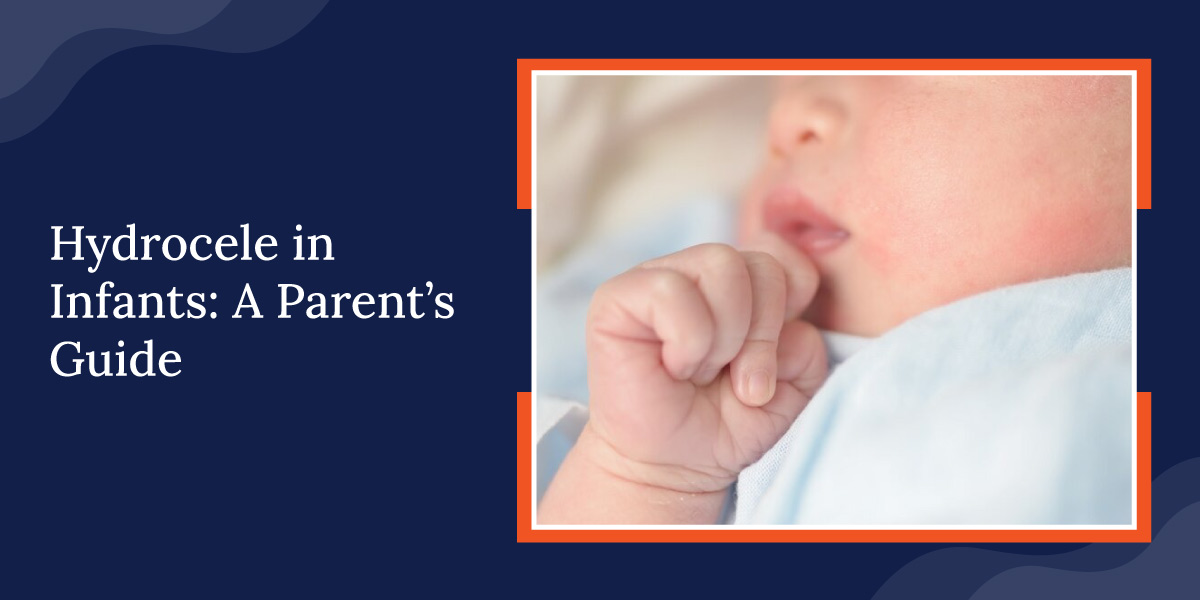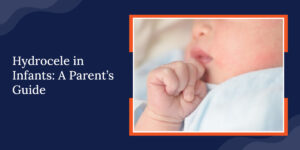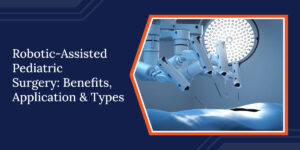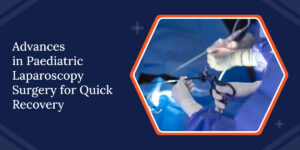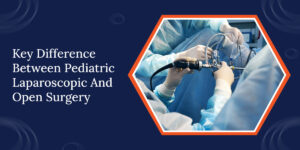A hydrocele is a buildup of fluid around one or both testicles. In children, it often appears shortly after birth and usually goes away without treatment. You may notice it during a diaper change or bath. It can look like swelling in the scrotum but often causes no pain or discomfort.
Knowing what a hydrocele is, what causes it, and when to speak to a doctor gives you a clear path forward if your child is affected.
A] Understanding Hydrocele
A hydrocele occurs when fluid collects in a sac around the testicle. This sac is a part of the normal development of the male reproductive system. In most cases, the body absorbs the fluid on its own.
You will hear two main terms when talking about hydroceles in children: congenital and acquired.
- Congenital hydrocele: This type of hydrocele is present at birth. It happens when the pathway between the abdomen and the scrotum, known as the processus vaginalis, stays open after the testicles have moved down into the scrotum. This opening allows fluid to pass into the scrotal sac.
- Acquired hydrocele: This is rare in children and usually occurs due to injury or infection. This form is more common in older children or teenagers. It may develop after trauma or inflammation near the testicle or groin.
Both types involve fluid, but the cause and treatment approach differ. In the case of hydrocele in newborn, the condition is often detected in the first few days or weeks after delivery and monitored during early well-baby visits.
Learn the signs of hydrocele in kids—get expert help now!
B] Causes of Hydrocele in Children
Most hydroceles in children are congenital. The issue begins before birth, when the testicles form inside the abdomen and move downward into the scrotum through the processus vaginalis.
That connection should close naturally either before or shortly after birth. If it remains open, fluid can enter the space around the testicle and cause swelling. These are among the most common causes of hydrocele in newborn boys.
An acquired hydrocele can result from:
- Direct injury to the testicle or groin
- Infections such as epididymitis
- Inflammation after surgery or medical conditions
In both types, the fluid causes the visible swelling, not the testicle itself.
C] Signs You May Notice
The most common sign is swelling in the scrotum. It is usually soft and painless. You might see it on one or both sides.
In congenital hydroceles, the swelling may change size throughout the day. It may increase when your child is active and decrease during sleep. The change in size is often related to fluid movement in and out of the open pathway.
If you’re unsure what to look for, it’s helpful to review the typical child hydrocele symptoms, which usually include a soft, fluid-like swelling in the scrotum without other signs of distress.
Other things to look for include:
- No redness or heat in the area
- No pain when the area is touched
- Normal behavior and energy levels
The lack of discomfort is a key point. If the swelling becomes hard, red, or painful, you should contact your doctor. Those signs may point to something more serious.
D] How a Hydrocele Is Diagnosed
Your child’s doctor will begin with a physical exam. You may be asked about when you first noticed the swelling and whether it changes during the day.
A simple test called transillumination is often used. This involves shining a small light through the scrotum. If light passes through, it suggests the swelling is filled with fluid, not solid tissue.
In some cases, your paediatric surgeon in Dubai may recommend an ultrasound. This imaging test helps confirm that the swelling is a hydrocele and not something else. It also checks for any signs of hernia or torsion, which would need different care.
Ultrasound is painless and safe. It gives a clear view of what is happening in the scrotum and helps guide the next steps. This approach is especially useful when checking for symptoms of hydrocele in children that might not match a typical case.
E] Treatment Options Based on Age and Type
If your child has a congenital hydrocele, treatment is usually not needed right away. Most of these cases go away on their own by the time the child is 12 to 18 months old. During that time, regular checkups help monitor the condition.
If the hydrocele does not go away or becomes larger, surgery may be recommended. The goal is to remove the fluid and close the open connection to prevent it from returning.
The procedure is called a hydrocelectomy. It is a short surgery done under general anesthesia. In most cases, your child can go home the same day. Recovery usually takes a few days, with minimal discomfort.
Surgery may be needed sooner if:
- The hydrocele becomes painful
- The swelling increases quickly
- A hernia is also present
- The hydrocele persists beyond 18 months
Parents often ask about hydrocele in newborn treatment, but in many cases, the best treatment is simply time and observation.
For acquired hydroceles, treatment focuses on the cause. If an infection or injury is involved, that will be addressed first. Paediatric robotic surgery may still be required if the fluid does not go away or causes discomfort.
F] When You Should Call a Doctor
Most hydroceles are harmless and resolve without treatment. Still, you should not ignore changes or warning signs.
Call your child’s doctor if you notice:
- Swelling that becomes red or painful.
- A rapid increase in size.
- Firmness instead of a soft feel.
- Signs of infection such as fever or irritability.
- The hydrocele is still present after your child’s first birthday.
You should also seek care if the swelling is very large or if you have concerns about testicle size or shape. It is important to confirm that nothing more serious is present, such as an inguinal hernia.
Even if the condition seems mild, regular checkups help track changes over time. Some types, such as hydrocele in neonates, require closer monitoring during the first few months of life to rule out other possible conditions.
G] What You Can Expect
A hydrocele in a child often looks more serious than it is. You may feel unsure when you first see the swelling, but most cases do not cause harm and do not affect fertility or development.
If your child needs surgery, the procedure is routine and low-risk. Recovery is smooth for most children. Your doctor will give you clear instructions about care after the procedure and any signs to watch for.
Whether your child’s hydrocele resolves on its own or requires surgery, consistent follow-up is the key to the best outcome. This is especially true for hydrocele in infant cases, where reassurance and guidance during development are important.
Learn the signs of hydrocele in kids—get expert help now!
Final Thought
Seeing swelling in your child’s scrotum can raise concerns. A hydrocele may seem alarming at first, but in most cases, it is a temporary condition that does not cause pain or lasting problems.
Knowing the signs, understanding the cause, and staying in close contact with your doctor puts you in the right position to manage it. Observation is enough for many children. If surgery is needed, it is a safe and effective option.
Regular visits with your pediatrician will give you the reassurance and guidance you need through each stage of the process. If you’re tracking your child’s development and notice changes linked to infant hydrocele, early diagnosis helps prevent unnecessary worry.

Dr. Bhushanrao Jadhav
Dr. Bhushanrao Jadhav is a highly skilled Pediatric Surgeon and Urologist specialising in minimally invasive and robotic surgeries for children. With advanced training from leading institutions in the UK, India and USA, he brings expertise in treating complex genitourinary conditions and neonatal surgical ailments. Driven by compassion and innovation, Dr. Jadhav has pioneered pediatric robotic surgery programs in Pune, India, ensuring world-class care tailored to children’s unique needs.

